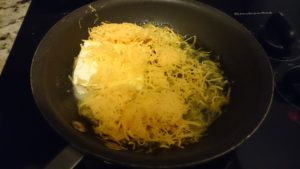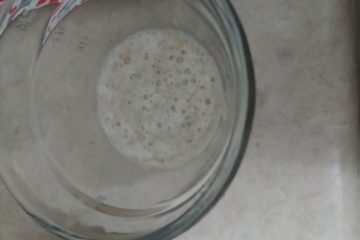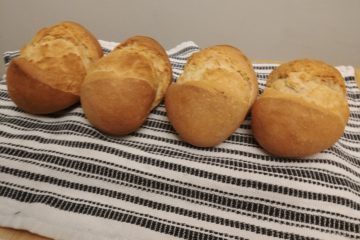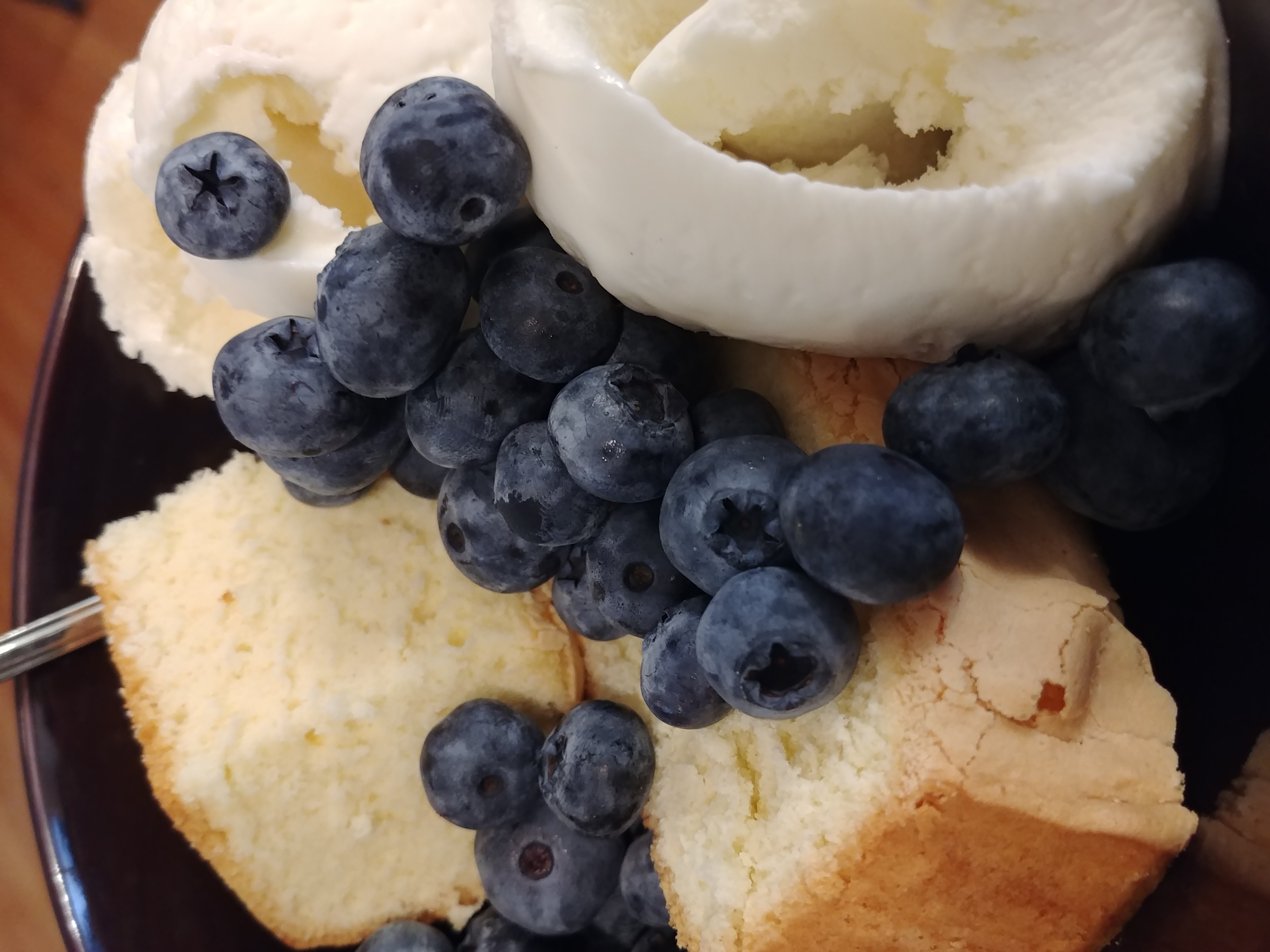38.
You can call it caws pobi, cause boby, or even Welsh rarebit or Welsh rabbit. It’s the same thing. It’s the food spoken of in 1542 by Andrew Boorde: “I am a Welshman, I do love cause boby, good roasted cheese.” (Fyrst Boke of the Introduction of Knowledge, 1542). There are earlier references to it, but by the 15th and 16th century it was essentially the Welsh national dish (First catch your peacock: The classic guide to Welsh food, B. Freeman, 1996, p. 31). It even shows up on a list of dishes presented in the late 15th century at Pembroke Castle by the Earl Marshal (likely Henry Tudor before becoming king):
Ballock broth, Caudle ferry, Lampreys en galentine, Oysters in civey, Eels in sorré, Baked Trout
Brawn with mustard, Numbles of a hart, Pigs y-farsed, Cockentryce
Goose in hogepotte Venison en frumenty, Hens in brewet, Squirrels roasted
Haggis of sheep, Pudding de capon-neck, Garbage, Trype de mouton, Blaundesorye, Caboges, Buttered worts
Apple muse, Gingerbread, Tart de fruit, Quinces in comfit
Essex cheese, Stilton cheese, Causs boby(Mediaeval Pageant, J.R. Reinhard, 1939, p. 42)[emphasis mine]
We know little about it at this time other than that Caws Pobi translates literally to “roasted cheese” (Freeman, 1996 p. 153). Because of this some people guess that it was probably similar to an open face grilled cheese sandwich. But that ignores the lineage and history.
First it’s difficult to make a hard cheese in Wales, but the Welsh liked their hard cheeses so it was a common import (The Oxford Companion to Food, A. Davidson, 2014, p. 858), cheddar was the most popular.
Second the dish still exists, there are many recipes but they boil down to essentially this (paraphrased from here):
Melt cheese, butter, ale, & spices in a pan, pour onto toast and broil.
That’s a far reach from toasting a piece of cheese on a piece of bread. Looking back we get a recipe for caws pobi in 1885 (purportedly from much earlier) the dish is a mixture of eggs, butter, & cheese cooked together as a type of dip (Cassell’s Dictionary of Cookery, 1885). An earlier recipe is cheese, butter, cream, and egg mixed together over heat then broiled (Freeman, 1996, p.155).
The trail gets even more interesting when we move to cookery books. There doesn’t seem to be any recipes for “roasted cheese” or “caws pobi” in English cookery books but we do get a dish called “Lese fryes” (Two Fifteenth-Century Cookery-Books, recipe from ~1430) or “Leche fryed” (Recipes from the Wagstaff Miscellany, recipe from ~1460) which adapts to “a Tarte of Cheese” in the 1500s (A Proper newe Booke of Cokerye & A Book of Cookrye). But Leche Fryed just means Fried Milk and it’s not a stretch to go from Fried Milk to Roasted Cheese, especially when the five recipes between 1430 and 1590 look like this:
- Cheese, eggs, butter, sugar (~1430)
- Cheese, butter, eggs, honey (~1460)
- Cheese, butter, eggs, cream (~1500)
- Cheese, eggs, butter (~1550)
- Cheese, milk, eggs, butter, sugar (1591)
In all cases melt cheese, mix with ingredients, roast in a coffin
The two simplest trains of thought on this are:
- The Welsh changed their “Roasted Cheese” dish sometime in the 17th or 18th century to match the English dish “Fried Milk”
- They’re the same dish
I’m going with #2 but I could be wrong.
Recipes:
Lese fryes. (Note: D. Leche frye3) Take nessh chese, and pare it clene, and grinde hit in a morter small, and drawe yolkes and white of egges thorgh a streynour, and cast there-to, and grinde hem togidre; then cast thereto Sugur, butter and salt, and put al togidre in a coffyn of faire paast, And lete bake ynowe, and then serue it forthe. (Two Fifteenth-Century Cookery-Books)
Mix ground softened cheese with eggs sugar, butter, and salt. Bake in a coffin.
Leche fryed. Take tendyr chese cut hit in shivers do hit in hote skallyng watyr when hit rennyth & yelleth to gedyr do a wey the watyr as clene as thu may & do ther ro claryfydd buttur al hote a grete dele & claryfyed hony & tayl hit well to gadyr with yolkes of eyron have cofyns with low bredrreys as thin as thu may draw hem put yn some stuf that the botom be helyd & let hem bake esyly & serve hem forth. (Recipes from the Wagstaff Miscellany)
Melt cheese (in water) then pour off water and mix with clarified butter, honey & egg yolks, bake in an open coffin.
For tarts owte of lente. Take neshe chese and pare hit and grynd hit yn A morter and breke egges and do ther to and then put yn buttur and creme and mell all well to gethur put not to moche butter ther yn if the chese be fatte make A coffyn of dowe and close hit a bove with dowe and collor hit a bove with the yolkes of eggs and bake hit well and serue hit furth. (Gentyll manly Cokere – MS Pepys 1047)
Mix ground softened cheese with eggs, butter, and cream, bake in a closed coffin.
To make a tarte of Chese. Take harde Chese and cutte it in slyces, and pare it, than laye it in fayre water, or in swete mylke, the space of three houres, then take it up and breake it in a morter tyll it be small, than drawe it up thorowe a strainer with the yolkes of syxe egges, and season it wyth suger and swete butter, and so bake it. (A Proper newe Booke of Cokerye)
Soften hard cheese (in water or milk), grind, mix with egg yolks sugar and butter, bake it.
To make a Tarte of Cheese. Take good fine paste and drive it as thin as you can. Then take cheese, pare it, mince it, and braye it in a morter with the yolks of Egs til it be like paste, then put it in a faire dish with clarified butter, and then put it abroade into your paste and cover it with a faire cut cover, and so bake it: that doon, serve it forth. (A Book of Cookrye)
Mix ground cheese with eggs & butter and bake it in a covered coffin.
Redaction:
- 1 cup aged cheddar (grated)
- 1/3 cup butter
- 2 eggs
- 2 tsp sugar
- pinch salt
- Coffin (pastry or stoneware)
- melt butter and cheddar together on low
- mix eggs, sugar, and salt
- mix melted cheese into eggs
- pour into coffin (open or closed)
- bake at 400f till browned
- (if in closed coffin) remove lid
Note: you can instead bake this on pieces of thick bread instead of the pastry.
This makes a delicious cheesy topping to your coffin or on bread. I can see why the Welsh loved it so much.




1 Comment
David Friedman · May 11, 2018 at 4:55 pm
You might also consider Digby’s Savory Toasted Cheese.